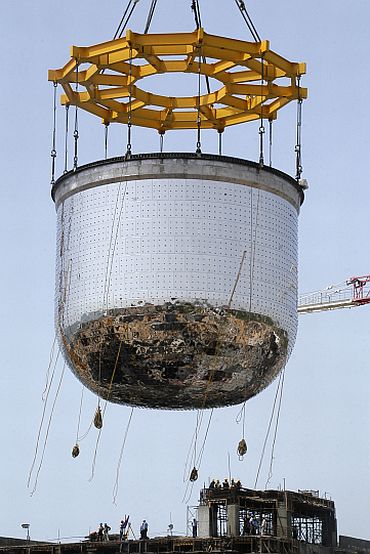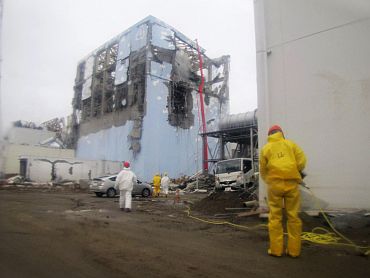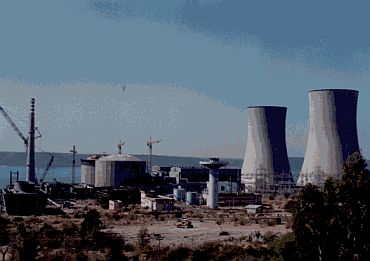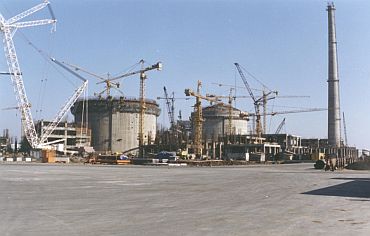Photographs: Babu/Reuters
Understanding the nuclear risk is the first step towards making India safe from the possible catastrophic impact of a natural disaster on its nuclear facilities. And public understanding depends on access to the information on that risk, says Mihir R Bhatt
Risk cannot be reduced without understanding it, and nuclear disaster risk is no exception. However, understanding nuclear disaster risk is perhaps more difficult, because it is covered up under scientific, expert driven and official secret procedures. Citizens are left in the dark.
In this light, or darkness shall we say, we should welcome the news that Prime Minister Manmohan Singh in Parliament called for an audit of our nuclear facilities on their resilience to disasters.
Learning from the losses of others is cost effective; and this audit is certainly a response to the devastating earthquake and tsunami in Japan that damaged the Fukushima nuclear power station.
The author working on review of District Disaster Management Plans in India
Please ..
India is clueless about the audit of its nuclear facilities
Image: Handout photograph shows efforts to spray water into the No. 4 reactor at the Fukushima Daiichi Nuclear Power Plant in northeastern JapanPhotographs: Reuters
Though the audit is happening in India, we do not know how long it will take. The Indian government should release some basic information on the safety of our nuclear facilities against disasters into the public domain.
This public access to information will help alleviate the general doubt surrounding this matter among members of Parliament and citizens. It will also help better inform the decisions made on this vitally important subject. Let me offer six sets of basic questions:
First, what are the planning and operational processes used when auditing the safety of nuclear facilities against a natural disaster? Though full details may not be needed at this stage, basic facts and figures on the processes will help citizens better understand the efforts made in the past by the authorities to make these facilities safer.
What is the participation structure for nuclear facilities?
Image: The Kundlakulam nuclear power plant, currently under construction, at Kudankulam in Tirunelveli distict of Tamil NaduPhotographs: Courtsey: Wikimedia Commons
Second, what is the accountability and participation structure for the facilities? If preparedness is lacking, who is responsible? What is the past record of incentives and disincentives for performance on this count? Who has been punished or promoted on this count in past 20 years? At what level? What actions are or can be taken in future? To what extent? At the moment it is not clear to the citizens who is accountable to whom, and an impression is created that expertise equals to accountability.
Third, how assessment teams are selected and how is their performance measured? What qualifications do they hold? Nuclear power is relatively new in India and thus, the field of nuclear and natural disaster risk overlaps in people's minds. However, it will be very important to understand more fully as India moves forward with its nuclear power expansion plans. Human resources and understanding on this issue will be more and more in demand.
What baseline data will be used for this audit?
Image: The Rajasthan atomic power station in RawatbhataPhotographs: Courtsey: Department of Atomic Power, Govt of India
Fourth, what baseline data will be used for this audit? Who collected that data and how? Who verified the data? Is baseline data India specific or global in nature? Citizens know very little about the status of safety in this sector and such information will build their confidence.
Fifth, what indicators are being used to measure the safety levels of these nuclear assets from the impact of a natural disaster? How have these indicators evolved? Who selected them and why? These indicators may be used to priorities certain stakeholders such as liability experts, local communities, insurance agencies and authorities. An all round audit must have an agreed set of indicators.
What has caused unsafe conditions in our nuclear facilities?
Image: The Tarapur atomic power station in MaharashtraPhotographs: Courtsey: Department of Atomic Power, Govt of India
Sixth, what has caused unsafe conditions in our nuclear facilities in the past and what was the effect of the resulting remedial measures? This information is important, as it demonstrates the care that the authorities took to fix even smallest emergencies in the past.
What is being asked in the above six sets of questions is nothing new and must be in the existing records of the central safety official to start with. Say three days time, this could be ready to be given to the citizens and the Members of Parliament.
Understanding nuclear risk is the first step towards making India safe from the possible catastrophic impact of a natural disaster on its nuclear facilities. And public understanding depends on access to the information on that risk.






article